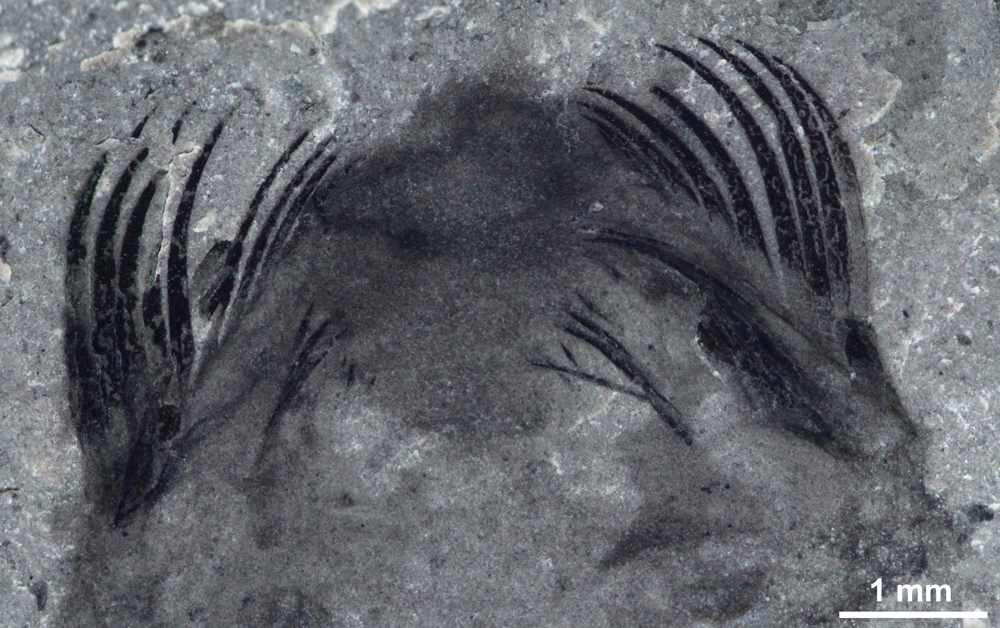Spiny Worm Beast Haunted the Seas 500 Million Years Ago
p.p1 {margin: 0.0px 0.0px 0.0px 0.0px; font: 14.0px Times}
This story was updated Aug. 4 at 3:29 p.m. EDT.
About 508 million years ago, a skinny, flat worm swam through the deep sea, waiting for the right moment to extend its 50 sharp spines and nab its next meal, a new study finds.
The 4-inch-long (10 centimeters) worm was small — about the length of a toilet paper roll — but its spines would have made it a formidable carnivore, at least for tiny prey, the researchers said.
"The grasping spines in the head — long and curved inward — were used to capture small swimming creatures like crustaceans (shrimp-like creatures) and larvae of other marine animals," study co-researcher Derek Briggs, a professor of paleontology at Yale University, told Live Science in an email. [See Images of the Ancient, Spiny Worm]
The newly identified creature belongs to a group of bristly jawed, carnivorous marine worms scientifically known as chaetognaths and commonly called arrowworms. Intriguingly, the newfound worm is one of the largest chaetognaths on record, and was likely a forerunner of today's smaller, plankton-eating chaetognaths, the researchers said.
The scientists named it Capinatator praetermissus, Latin for "overlooked grasping swimmer." (In Latin, "Capio" and "natator" mean "to grasp" and "swimmer," respectively. The species name is Latin for "overlooked," reflecting the more than 30 years it took to name and describe the species.)
Sign up for the Live Science daily newsletter now
Get the world’s most fascinating discoveries delivered straight to your inbox.
From 1983 to 2016, researchers uncovered 49 C. praetermissus specimens in British Columbia's Burgess Shale deposit in the Canadian Rockies, a region known for holding innumerable fossils from the Cambrian period, which lasted from about 543 million to about 490 million years ago. However, the researchers didn't have enough information to formally describe the critters until this year, they said.

During its lifetime in the middle Cambrian, C. praetermissus swam by undulating its slender body. But its head was the attention grabber: It had about 25 curving spines on each side of its head — almost double the number of spines chaetognaths have today. When it spotted a potential meal, C. praetermissus would have deployed its spines outward and closed them together over the hapless prey.
"Darting from the water depths, the spines would have been a terrifying sight to many of the smallest marine creatures that lived during that time," study co-researcher Jean-Bernard Caron, a senior curator of invertebrate paleontology at the Royal Ontario Museum and an associate professor at the University of Toronto, said in a statement.
It's common to find fossilized chaetognath spines, but it's rare to unearth fossils containing the remains of soft tissues, as researchers did for this study, Briggs noted.
"The specimens preserve evidence of features such as the gut and muscles, which normally decay away, as well as the more decay-resistant grasping spines," Briggs said in the statement. "They show that chaetognath predators evolved during the explosion of marine diversity during the Cambrian period, and were an important component of some of the earliest marine ecosystems.”

C. praetermissus is hardly the only spiny worm from the Cambrian. Other wormy monsters include Collinsium ciliosum, a spiky, worm-like creature with 30 legs that were either feathery or tipped with claws, from 518 million years ago; Ottoia prolifica, a toothy, penis-shaped worm that lived 508 million years ago; and Hallucigenia sparsa, a spiky worm with a toothy grin from 508 million years ago.
The new study was published online today (Aug. 3) in the journal Current Biology.
Editor's Note: This article was updated to fix the age of Ottoia prolifica. At the time the O. prolifica study was published, the Burgess Shale site was dated to 505 million years ago. But within the past few years, improved evidence has helped researchers pin it to 508 million years ago, although there is still a margin of error for that date. Regardless, it's important to note that both C. praetermissus and O. prolifica are the same age.
Original article on Live Science.

Laura is the archaeology and Life's Little Mysteries editor at Live Science. She also reports on general science, including paleontology. Her work has appeared in The New York Times, Scholastic, Popular Science and Spectrum, a site on autism research. She has won multiple awards from the Society of Professional Journalists and the Washington Newspaper Publishers Association for her reporting at a weekly newspaper near Seattle. Laura holds a bachelor's degree in English literature and psychology from Washington University in St. Louis and a master's degree in science writing from NYU.









